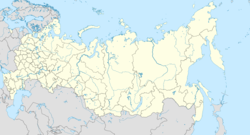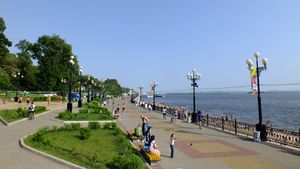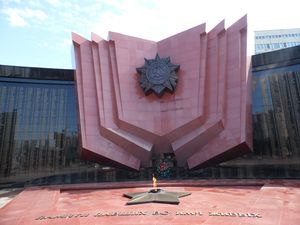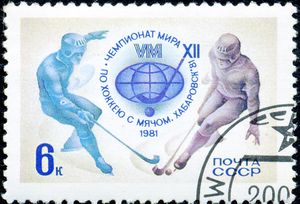خبروڤسك
{{ safesubst:#invoke:Unsubst||date=__DATE__|$B=
خبروڤسك
Хабаровск Khabarovsk | |
|---|---|
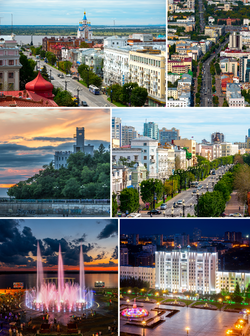 | |
| النشيد: نشيد خبروڤسك[2] | |
| الإحداثيات: 48°29′N 135°05′E / 48.483°N 135.083°E | |
| البلد | روسيا |
| الكيان الاتحادي | Khabarovsk Krai[3] |
| Founded | May 31, 1858[4] |
| مدينة status since | 1880[5] |
| الحكومة | |
| • الكيان | City Duma[6] |
| • Mayor[6] | Sergei Kravchuk[7] |
| المساحة | |
| • الإجمالي | 400 كم² (200 ميل²) |
| المنسوب | 72 m (236 ft) |
| التعداد | |
| • الإجمالي | 577٬441 |
| • Estimate (2018) | 618٬150 (+7%) |
| • الترتيب | 26th in 2010 |
| • الكثافة | 1٬400/km2 (3٬700/sq mi) |
| • Subordinated to | city of krai significance of Khabarovsk[1] |
| • Capital of | Khabarovsk Krai[3], city of krai significance of Khabarovsk[10] |
| • Urban okrug | Khabarovsk Urban Okrug[11] |
| • Capital of | Khabarovsk Urban Okrug[11], Khabarovsky Municipal District[12] |
| منطقة التوقيت | UTC+ ([13]) |
| Postal code(s)[14] | 680000–680003, 680006, 680007, 680009, 680011–680015, 680017, 680018, 680020–680023, 680025, 680026, 680028–680033, 680035, 680038, 680040–680043, 680045, 680047, 680051, 680052, 680054, 680055, 680700, 680880, 680890, 680899, 680921, 680950, 680960–680967, 680970, 680999, 901183, 901185 |
| Dialing code(s) | +7 4212 |
| OKTMO ID | 08701000001 |
| مدينة Day | Last Sunday of May[4] |
| الموقع الإلكتروني | khabarovskadm |
| 2010 Census | 577,441[9] |
|---|---|
| 2002 Census | 583,072[15] |
| 1989 Census | 600,623[16] |
| 1979 Census | 527,848[17] |
خبروڤسك (Khabarovsk ؛ روسية: Хаба́ровск, النطق Khabarovsk; النطق الروسي: [xɐˈbarəfsk] (![]() استمع)) is the largest city and the administrative center of Khabarovsk Krai, Russia,[3] located 30 كيلومتر (19 mi) from the Chinese border, at the confluence of the Amur and Ussuri Rivers, about 800 كيلومتر (500 mi) north of Vladivostok. The city was the administrative center of the Far Eastern Federal District of Russia from 2002 until December 2018, when Vladivostok took over that role.[18] It is the largest city in the Russian Far East, having overtaken Vladivostok in 2015. As of the 2010 Census, its population was 577,441.[9] It was previously known as Khabarovka (until 1893).[5]
استمع)) is the largest city and the administrative center of Khabarovsk Krai, Russia,[3] located 30 كيلومتر (19 mi) from the Chinese border, at the confluence of the Amur and Ussuri Rivers, about 800 كيلومتر (500 mi) north of Vladivostok. The city was the administrative center of the Far Eastern Federal District of Russia from 2002 until December 2018, when Vladivostok took over that role.[18] It is the largest city in the Russian Far East, having overtaken Vladivostok in 2015. As of the 2010 Census, its population was 577,441.[9] It was previously known as Khabarovka (until 1893).[5]
التاريخ
أقدم سجل
Historical records indicate that Khabarovsk was founded in the eighth century. The Tungusic peoples are indigenous to the city's vicinity. The city was named "Boli" under Chinese occupation. During the Tang Dynasty, Boli was the capital of Heishui Protectorate, called Heishui Duhufu. [19] In A.D. 722, Emperor Xuanzong of Tang (唐玄宗) established Heishui Protectorate and gave self-rule to Heishui Mohe tribes. Then, the capital city of this administrative region in the area of Habarovsk had been constructed.[20][21]
المستكشفون الروس في القرن 17
In the mid-17th century, the Amur Valley became the scene of hostilities between the Russian Cossacks, who tried to expand into the region and collect tribute from the natives, and the rising Manchu Qing Dynasty, who were intent on securing the region for themselves.
أتشانسك لخبروڤ
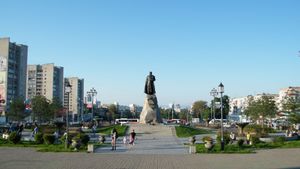
The Russian explorers and raiders of the 1650s set up a number of more or less fortified camps (ostrogs) on the Amur. Most of them were in use for only a few months, and later destroyed. It is usually thought that the first such camp in the general area of today's Khabarovsk was the fortified winter camp named Achansk (Ачанск) or Achansky gorodok (Ачанский городок), built by the Cossacks of Yerofey Khabarov in September 1651 after they had sailed to the area from the upper Amur. The fort was named after the local tribe whom Khabarov's people called "Achans".[22][23] Already on October 8 the fort was unsuccessfully attacked by joint forces of Achans and Duchers (who had good reasons to hate the Cossacks, due to their rather heavy-handed tribute-extraction tactics[24]), while many Russians were away fishing.[23] In late November, Khabarov's people undertook a three-day campaign against the local chief Zhakshur (Жакшур) (whose name is also known in a more Russian version, Zaksor (Заксор)), collecting a large amount of tribute and announcing that the locals were now subjects of the Russian Czar. Similar campaign was waged later in winter against the Ducher chief Nechiga (Нечига), farther away from Achansk.[23]
On March 24 (or 26), 1652, Fort Achansk was attacked by Manchu cavalry, led by Ninguta's commander Haise, reinforced by Ducher auxiliaries, but the Cossacks stood their ground in a day-long battle and even managed to seize the attackers' supply train.[23] Once the ice on the Amur broke in the spring of 1652, Khabarov's people destroyed their fort and sailed away.[23]
The exact location of Khabarov's Achansk has long been a subject for the debate among Russian historians and geographers.[24][25] A number of locations, both upstream and downstream of today's Khabarovsk, have been proposed since Richard Maack, one of the first Russian scholars to visit the region, identified Achansk in 1859 with the ruins on Cape Kyrma, which is located on the southern (Chinese) shore of the Amur, upstream of Khabarovsk.[24] The most widely accepted point of view is probably that of Boris Polevoy, who believed that Khabarov's Achansk was located in the Nanai village later known as Odzhal-Bolon (روسية: Оджал-Болонь), located on the left bank of the Amur, closer to Amursk than to Khabarovsk. One of his arguments was that both Khabarov's Achan (sometimes also spelled by the explorer as Otshchan, Отщан), and Wuzhala (乌扎拉) of the Chinese records of the 1652 engagement are based on the name of the Nanai clan "Odzhal" (Оджал), corresponding to the 20th-century name of the village as well. (The name of the clan was also written as "Uzala", as in the name of its best-known member, Dersu Uzala).[24]
Polevoy's view appeared to gain wide support among the Russian geographer community; petitioned by the Amur Branch of the Russian Geographical Society, the Russian Government renamed the village of Odzhal to Achan in 1977, to celebrate its connection with Khabarov's raid.[24]
As to the Cape Kyrma ruins, thought by Maack to be the remains of Achansk, B.P. Polevoy identified them as the remains of another ostrog - namely, Kosogorsky Ostrog, where Onufriy Stepanov stayed a few years later.[25]
امبراطورية تشينگ
After the Treaty of Nerchinsk (1689), the area became an uncontested part of the Qing Empire for the next century and a half. Modern historical maps of the Qing period published in China mark the site of future Khabarovsk as Bólì (الصينية: 伯力). All of the middle and lower Amur region was nominally part of the Jilin Province, run first out of Ninguta and later out of Jilin City.
French Jesuits who sailed along the Ussuri and the Amur Rivers in 1709 prepared the first more or less precise map of the region. According to them, the indigenous Nanai people were living on the Ussuri and on the Amur down to the mouth of the Dondon River (i.e., in the region including the site of the future Khabarovsk). These people were known to the Chinese as Yupi Dazi ("Fish skin Tartars").[26]
من خبروڤكا إلى خبروڤسك
In 1858, the area was ceded to Russia under the Treaty of Aigun. The Russians founded the military outpost of Khabarovka (Хаба́ровка),[بحاجة لمصدر] named after Yerofey Khabarov. The post later became an important industrial center for the region. Town status was granted in 1880; in 1893, it was given its present name.[5]
In 1894, a department of Russian Geographical Society was formed in Khabarovsk and to found libraries, theatres and museums in the city. Since then, Khabarovsk's cultural life has flourished. Much of the local indigenous history has been well preserved in the Regional Lore Museum and Natural History Museum and in places like near the Nanai settlement of Sikachi-Alyan, where cliff drawings from more than 13,000 years ago can be found. The Khabarovsk Art Museum exhibits a rare collection of old Russian icons.
In 1916, the Khabarovsk Bridge across the Amur was completed, allowing Trans-Siberian trains to cross the river without using ferries (or temporary rail tracks over the frozen river in winter).
العهد السوڤيتي
After the defeat of Japan in World War II, Khabarovsk was the site of the Khabarovsk War Crime Trials, in which twelve former members of the Japanese Kwantung Army and Unit 731 were put on trial for the manufacture and use of biological weapons during World War II.
Chinese Emperor Puyi, captured by Soviet troops in Manchuria, was relocated to Khabarovsk and lived there from 1945 up to 1950, when he was returned to China.[27]
When Japan fell in September 1945 the United States reached an agreement with Stalin to build two U.S. Naval Advance Bases (Fleet Weather Centrals) in the USSR.[28] The U.S built one 10 ميل (16 km) outside Petropavlovsk-Kamchatsky on the Kamchatka Peninsula with the code name TAMA.[29] The other was 20 ميل (32 km) outside Khabarovsk in buildings provided by the Soviets, code-named MOKO.[29] For mail Khabarovsk was assigned U.S.Navy number 1168, FPO San Francisco.[30] The American use of these two bases was short-lived.
On 5 November 1956, the first phase of the city tram was commissioned. The Khabarovsk television studio began broadcasting in 1960. On 1 September 1967, the Khabarovsk Institute of Physical Education, now the Far Eastern State Academy of Physical Culture, opened. On 14 January 1971 Khabarovsk was awarded the Order of October Revolution. In 1975 the first stage of the urban trolley opened. In 1976 the city hosted an international ice hockey tournament with the ball for the prize of the newspaper Sovietskaya Rossia. In 1981 the Bandy World Championship was played in the city.
روسيا الاتحادية
In 1996, Khabarovsk held its first mayoral elections. Paul D. Filippov, whose candidacy was supported by Governor Viktor Ishayev, was defeated. In 1998, reconstruction of the central square of Khabarovsk was completed. In May 2000, President of Russia, Vladimir Putin, decreed that new federal districts be formed, and Khabarovsk became the center of the Far Eastern Federal District.
In 2006, the Center for Cardiovascular Surgery, a high-tech medical center, was constructed according to a Russian national health project. In 2008, the train station was completely renovated, and the adjacent square was reconstructed to include fountains and an underground passage. In 2009, Khabarovsk hosted the EU-Russia summit. In 2010, the city hosted a meeting of the Great Circle of Ussuri Cossacks. On 3 November 2012, Khabarovsk was awarded the honorary title of "City of Military Glory".
الوضع الاداري والبلدي
Khabarovsk is the administrative center of the krai[3] and, within the framework of administrative divisions, it also serves as the administrative center of Khabarovsky District,[31] even though it is not a part of it.[1] As an administrative division, it is incorporated separately as the city of krai significance of Khabarovsk—an administrative unit with the status equal to that of the districts.[1] As a municipal division, the city of krai significance of Khabarovsk is incorporated as Khabarovsk Urban Okrug.[11]
الجغرافيا
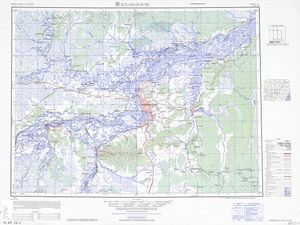
المناخ
| خبروڤسك | ||||||||||||||||||||||||||||||||||||||||||||||||||||||||||||
|---|---|---|---|---|---|---|---|---|---|---|---|---|---|---|---|---|---|---|---|---|---|---|---|---|---|---|---|---|---|---|---|---|---|---|---|---|---|---|---|---|---|---|---|---|---|---|---|---|---|---|---|---|---|---|---|---|---|---|---|---|
| جدول طقس (التفسير) | ||||||||||||||||||||||||||||||||||||||||||||||||||||||||||||
| ||||||||||||||||||||||||||||||||||||||||||||||||||||||||||||
| ||||||||||||||||||||||||||||||||||||||||||||||||||||||||||||
Khabarovsk experiences a monsoonal dry-winter humid continental climate (Köppen climate classification Dwb borders on Dwa).
The average annual precipitation is 682 ميليمتر (26.9 in), mainly concentrated in the summer. In a few years, November to March hardly receive any precipitation. The driest year was 2001 with only 381 ميليمتر (15.0 in) of precipitation and the wettest was 1981 when 1،105 ميليمتر (43.5 in) of precipitation fell. The wettest month was August 1981 with a total precipitation of 434 ميليمتر (17.1 in). Snowfall is common, though light, with an average maximum snow height of 16 سنتيمتر (6.3 in).
The city's extreme climate sees daily average high and low temperatures vary by around 50 °C (90 °F) over the course of the year. The average temperature in January is −19.8 °C (−3.6 °F) and the average for July is +21.3 °C (70.3 °F). Extremes have ranged from −40 °C (−40 °F) in January 2011 to +36.4 °C (97.5 °F) in June 2010.[32]
| بيانات المناخ لـ خبروڤسك | |||||||||||||
|---|---|---|---|---|---|---|---|---|---|---|---|---|---|
| الشهر | ينا | فب | مار | أبر | ماي | يون | يول | أغس | سبت | أكت | نوف | ديس | السنة |
| القصوى القياسية °س (°ف) | 0.6 (33.1) |
6.3 (43.3) |
17.0 (62.6) |
28.6 (83.5) |
31.5 (88.7) |
36.4 (97.5) |
35.7 (96.3) |
35.6 (96.1) |
29.8 (85.6) |
25.8 (78.4) |
15.5 (59.9) |
6.6 (43.9) |
36.4 (97.5) |
| متوسط القصوى اليومية °س (°ف) | −15.7 (3.7) |
−10.7 (12.7) |
−1.5 (29.3) |
10.4 (50.7) |
18.6 (65.5) |
23.9 (75.0) |
26.6 (79.9) |
24.8 (76.6) |
19.1 (66.4) |
10.0 (50.0) |
−3.1 (26.4) |
−13.5 (7.7) |
7.4 (45.3) |
| المتوسط اليومي °س (°ف) | −19.8 (−3.6) |
−15.4 (4.3) |
−6.4 (20.5) |
4.8 (40.6) |
12.4 (54.3) |
18.1 (64.6) |
21.3 (70.3) |
19.9 (67.8) |
13.7 (56.7) |
5.1 (41.2) |
−7.2 (19.0) |
−17.3 (0.9) |
2.4 (36.3) |
| متوسط الدنيا اليومية °س (°ف) | −23.5 (−10.3) |
−19.7 (−3.5) |
−11.0 (12.2) |
0.1 (32.2) |
7.1 (44.8) |
13.0 (55.4) |
16.8 (62.2) |
15.9 (60.6) |
9.2 (48.6) |
1.0 (33.8) |
−10.6 (12.9) |
−20.6 (−5.1) |
−1.9 (28.6) |
| الصغرى القياسية °س (°ف) | −40.0 (−40.0) |
−35.1 (−31.2) |
−28.9 (−20.0) |
−15.1 (4.8) |
−3.1 (26.4) |
2.2 (36.0) |
6.8 (44.2) |
4.9 (40.8) |
−3.3 (26.1) |
−15.6 (3.9) |
−27.4 (−17.3) |
−36.7 (−34.1) |
−40.0 (−40.0) |
| متوسط تساقط الأمطار mm (inches) | 14 (0.6) |
11 (0.4) |
22 (0.9) |
44 (1.7) |
61 (2.4) |
72 (2.8) |
133 (5.2) |
153 (6.0) |
79 (3.1) |
50 (2.0) |
26 (1.0) |
17 (0.7) |
682 (26.9) |
| Average rainy days | 0 | 0 | 1 | 10 | 16 | 15 | 15 | 17 | 15 | 11 | 2 | 0 | 102 |
| متوسط الرطوبة النسبية (%) | 75 | 72 | 68 | 63 | 65 | 74 | 79 | 83 | 78 | 67 | 69 | 73 | 72 |
| Mean monthly ساعات سطوع الشمس | 147 | 181 | 231 | 213 | 242 | 262 | 248 | 217 | 212 | 189 | 159 | 145 | 2٬446 |
| Source 1: Pogoda.ru.net[32] | |||||||||||||
| Source 2: NOAA (sun, 1961–1990)[33] | |||||||||||||
الاقتصاد والبنية التحتية
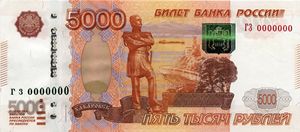
Primary industries include iron processing, steel milling, Khabarovsk shipyard, Daldizel, machinery, petroleum refining, flour milling, pharmaceutical industry, meat packing and manufacturing of various types of heavy and light machinery.
A high-speed international fiber-optic cable connects the city of Khabarovsk with the city of Fuyuan in China.
النقل

The city is principal railway center and is located along the Trans-Siberian Railway; the rail distance of Khabarovsk railway station from Moscow is 8،523 كيلومتر (5،296 mi).
Khabarovsk is served by the Khabarovsk Novy Airport with international flights to East Asia, Southeast Asia, European Russia, and Central Asia.
Road links include the Trans-Siberian Highway (M58 and M60 Highways), and water transport links are provided by the Amur River and Ussuri River.
Public transport includes: tram (8 routes); trolleybus (4 routes); bus and fixed-route taxi (marshrutka, approximately 100 routes).
التعليم
There are the following institutions of higher education in Khabarovsk:[34][35]
- Pacific National University (former Khabarovsk State University of Technology)
- Far Eastern State University of Humanities (former Khabarovsk State Teachers Training University)
- Far Eastern State Medical University
- Khabarovsk State Academy of Economics and Law
- Far Eastern State Transport University
- Far Eastern Academy of Public Service
- Far Eastern State Physical Education University
- Khabarovsk State Institute of Arts and Culture
السياحة
A key street in Khabarovsk is the broad Amursky Boulevard with its many shops and a local market. The city's five districts stretch for 45 كيلومتر (28 mi) along the Amur River. The similar boulevard - Ussuryisky is located between the two main streets Muravyov-Amursky and Lenin street and runs to the city's artificial lakes (Gorodskie Prudi) with the sport complex Platinum Arena. The lakes are famous for their fountains with the light show. The Military History Museum of the Far Eastern Military District is located in the city, the only such museum in the Russian Far East.[36]
Recently,[when?] there have been renovations in the city's central part, rebuilding with historical perspective. There is a walking tour from the Lenin Square to Utyos on Amur via Muravyov-Amursky Street, where visitors find traditional Russian cuisine restaurants and shops with souvenirs.[بحاجة لمصدر] There are a number of night clubs and pubs in this area. In Wintertime ice sculptures are on display on the cities squares and parks. Artists come from as far as Harbin in China.
Unlike Vladivostok, the city has never been closed to foreigners, despite it being the headquarters of the Far East Military District, and retains its historically international flavor. Once the capital of the Soviet Far East (from 1926 to 1938), since the demise of the Soviet Union, it has experienced an increased Asian presence. It is estimated that over one million Chinese travel to and through Khabarovsk yearly, and foreign investment by Japanese and Korean corporations has grown in recent years. The city has a multi-story shopping mall and about a dozen hotels.
Aleksandr Fedosov, the Khabarovsk Krai Minister of Culture, estimates that the city became more attractive to tourists following the 2015 Bandy World Championship.[37]
Khabarovsk is the closest major city to Birobidzhan, which is the administrative center of the Jewish Autonomous Oblast, Russia, located on the Trans-Siberian Railway, close to the border with China. The Jewish Autonomous Oblast is a federal subject of Russia in the Russian Far East, bordering Khabarovsk Krai and Amur Oblast in Russia and Heilongjiang province in China. Its administrative center is the town of Birobidzhan, and it is the only region in the world in that Yiddish is the official language. Khabarovsk provides the closest major airport to Birobidzhan, which is Khabarovsk Novy Airport (KHV / UHHH), 198 km from the center of Birobidzhan.
العسكرية
The headquarters of the Russian Ground Forces's Eastern Military District is located at 15 Serysheva Street. The district was preceded by the Far Eastern Military District, which was located in the same location. The following component units of the district are stationed in the city:
- 104th Cluj Headquarters Brigade
- Honour Guard Company of the Khabarovsk Garrison[38][39]
- 17th Independent Electronic Warfare Brigade
- 118th Independent Pontoon-Bridge Railway Battalion
- 392nd Pacific Training Center for Junior Specialists
- 11th Air and Air Defence Forces Army
- Military Band of the Eastern Military District
All 5 of these units make up the Khabarovsk Garrison. The Russian Navy's Pacific Fleet maintains a presence in the city as well. There is also an air base located 3 km (1.9 mi) to the east of the city. The main public relations asset for the military in the city is the Military History Museum of the Far Eastern Military District and the district military band.
الرياضة
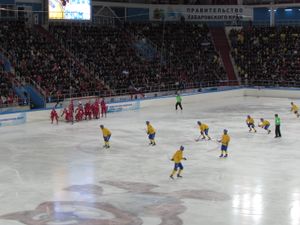
- Amur Khabarovsk, a professional ice hockey club of the international Kontinental Hockey League and plays its home games at the Platinum Arena. It used to be the easternmost-based team in the league until Admiral Vladivostok joined the KHL in 2013 as an expansion team.
- FC SKA-Khabarovsk, a professional association football team playing in the Russian Premier League, the top tier of Russian association football.
- SKA-Neftyanik, a professional bandy club which plays in the top-tier Russian Bandy Super League at its own indoor venue Arena Yerofey. It is both the easternmost and southernmost team in the top division. In the 2016-17 season the club became Russian champion for the first time.[40] As of 2019 the team has won the title three years in a row.[41]
أحداث دولية
The city was a host to the 1981 Bandy World Championship. It also hosted the 2015 Bandy World Championship, which was visited by Prime Minister Dmitry Medvedev.[42] 21 teams were expected,[43] which would have been 4 more than the then record-making 17 (now it's 18) from the 2014 tournament. In the end, China was the only newcomer, while Canada and Ukraine withdrew, the latter for political reasons. Khabarovsk organised the 2018 tournament as well, but not Division B that time around, which was held in Chinese Harbin.[44] The event was named by the Federal Agency for Tourism as one of the best 200 events of the year.[37]
الزيارات الهامة
A delegation from the 2022 Winter Olympics organising committee will visit Khabarovsk to watch matches in the bandy league, since they are considering letting bandy be a part of the programme in 2022.[45]
أبرز أولادها
- Oleksandr Aliyev, association football player
- Sergei Bodrov, filmmaker
- Evgeny Grachev, ice hockey player
- Mikhail Grigorenko, ice hockey player
- Alexandra Ivanovskaya, 2005 Miss Russia winner
- Alexander Mogilny, ice hockey player
- Evgeni Plushenko, Olympic figure skater
- Ivan Skobrev, speed skater
- Andrei Tchmil, professional cyclist
- Efim Zelmanov, mathematician
- Ivan Koumaev, dancer
- Andrey Zamkovoy, boxer
- Vita Sidorkina, model
- Vladimir Volegov, painter
- Denis Kenzo, music producer
- Daria Usacheva, figure skater
البلدات التوأم – المدن الشقيقة
Khabarovsk is twinned with:[46]
الجوائز
- Khabarovsk placed first in different categories of "Most Developed and Comfortable City of Russia" in 2006,[47] 2008[48] and 2009.
- In 2010, Khabarovsk won the second place in the Forbes list of most suitable cities for private business in Russia.[49] First place went to Krasnodar.
انظر أيضاً
المراجع
الهامش
- ^ أ ب ت ث Resolution #143-pr
- ^ Decision #856
- ^ أ ب ت ث Law #109
- ^ أ ب Charter of Khabarovsk, Article 2
- ^ أ ب ت Энциклопедия Города России. Moscow: Большая Российская Энциклопедия. 2003. p. 503. ISBN 5-7107-7399-9.
- ^ أ ب Charter of Khabarovsk, Article 19
- ^ Official website of Khabarovsk. Sergei Anatolyevich Kravchuk, Mayor of Khabarovsk (in روسية)
- ^ Official website of Khabarovsk. Brief Reference (in روسية)
- ^ أ ب ت Russian Federal State Statistics Service (2011). "Всероссийская перепись населения 2010 года. Том 1". Всероссийская перепись населения 2010 года (2010 All-Russia Population Census) (in Russian). Federal State Statistics Service. Retrieved June 29, 2012.
{{cite web}}: Invalid|ref=harv(help); Unknown parameter|trans_title=ignored (|trans-title=suggested) (help)CS1 maint: unrecognized language (link) - ^ قالب:OKATO reference
- ^ أ ب ت Law #177
- ^ Law #264
- ^ "Об исчислении времени". Официальный интернет-портал правовой информации (in Russian). 3 June 2011. Retrieved 19 January 2019.
{{cite web}}: CS1 maint: unrecognized language (link) - ^ Почта России. Информационно-вычислительный центр ОАСУ РПО. (Russian Post). Поиск объектов почтовой связи (Postal Objects Search) (in روسية)
- ^ Russian Federal State Statistics Service (May 21, 2004). "Численность населения России, субъектов Российской Федерации в составе федеральных округов, районов, городских поселений, сельских населённых пунктов – районных центров и сельских населённых пунктов с населением 3 тысячи и более человек" (XLS). Всероссийская перепись населения 2002 года [All-Russia Population Census of 2002] (in Russian). Retrieved August 9, 2014.
{{cite web}}: Invalid|ref=harv(help); Unknown parameter|trans_title=ignored (|trans-title=suggested) (help)CS1 maint: unrecognized language (link) - ^ Demoscope Weekly (1989). "Всесоюзная перепись населения 1989 г. Численность наличного населения союзных и автономных республик, автономных областей и округов, краёв, областей, районов, городских поселений и сёл-райцентров". Всесоюзная перепись населения 1989 года[All-Union Population Census of 1989] (in Russian). Институт демографии Национального исследовательского университета: Высшая школа экономики [Institute of Demography at the National Research University: Higher School of Economics]. Retrieved August 9, 2014.
{{cite web}}: Invalid|ref=harv(help); Unknown parameter|trans_title=ignored (|trans-title=suggested) (help)CS1 maint: unrecognized language (link) - ^ "Всесоюзная перепись населения 1979 г. Национальный состав населения по регионам России. (All Union Population Census of 1979. Ethnic composition of the population by regions of Russia.)". Всесоюзная перепись населения 1979 года (All-Union Population Census of 1979) (in Russian). Demoscope Weekly (website of the Institute of Demographics of the State University—Higher School of Economics. 1979. Retrieved 2008-11-25.
{{cite web}}: Italic or bold markup not allowed in:|publisher=(help)CS1 maint: unrecognized language (link) - ^ "Путин перенес столицу Дальневосточного федерального округа во Владивосток". meduza.io. Retrieved 2018-12-13.
- ^ hellotravel, https://www.hellotravel.com/russia/khabarovsk
- ^ 《新唐書·北狄傳》記載:「黑水西北又有思慕部,益北行十日得郡利部,東北行十日得窟說部,亦號屈設,稍東南行十日得莫曳皆部。」。(The "New Tang Dynasty Book of Beidi" records: "There is also a tribe called “Dream Tribe” in the northwest of Heishui, Yibei travels on the 10th days to the “County Tribe”, and the northeast travels on the 10th days to the “Cave Tribe”. 10th days to the “Mo Mo Tribe”)
- ^ 唐玄宗封黑水部酋长倪属利稽为勃利州刺史。"勃利"就是今黑龙江、乌苏里江汇合处 黑水军和黑水都督府,赐 的伯力(今苏联境内哈巴罗夫斯克). Heilongjiang Provincial Highway Traffic History Editing Office, "History of Ancient Road Traffic in Heilongjiang", Published by People's Communications Press 1988, ISBN 7-114-00315-3. (https://books.google.com/books?id=6704AAAAIAAJ&dq=editions:LCCN90172212)
- ^ Археологи обнаружили на Амуре таинственный городок. Возможно, это первое русское поселение в данном регионе Archived مايو 25, 2006 at the Wayback Machine (Mysterious fort found by archaeologists on the Amur. Possibly, this is the first Russian settlement in this region) (in روسية)
- ^ أ ب ت ث ج Оксана Гайнутдинова (Oksana Gaynutdinova) Загадка Ачанского городка Archived أغسطس 13, 2007 at the Wayback Machine (The mystery of Fort Achansk)
- ^ أ ب ت ث ج B.P. Polevoy (Б.П. Полевой), Изветная челобитная С. В. Полякова 1653 г. и ее значение для археологов Приамурья (S.V. Polyakov's denouncing letter (1653), and its significance for the archaeologists of the Amur Valley), in: Русские первопроходцы на Дальнем Востоке в XVII-XIX вв. (Историко-археологические исследования) (First Russian explorers in the Far East in the 17th-19th centuries: Historical and archaeological research - B.P.Polevoy's preface to the document), vol. 2, Vladivostok, Russian Academy of Sciences, 1995. (This article also contains references to Polevoy's earlier publications) (in روسية)
- ^ أ ب Б.П. Полевой (B.P. Polevoy) О подлинном местоположении Косогорского острога 50-х гг. XVII века (About the true location of the Kosogorsky Ostrog of the 1650s) (in روسية)
- ^ Du Halde, Jean-Baptiste (1735). Description géographique, historique, chronologique, politique et physique de l'empire de la Chine et de la Tartarie chinoise. Vol. Volume IV. Paris: P.G. Lemercier. p. 7.
{{cite book}}:|volume=has extra text (help) Numerous later editions are available as well, including one on Google Books - ^ http://khv9923.narod.ru/His_last_translator.pdf
- ^ The 114th CB cruisebook, 1946, U.S.Navy Seabee Museum Archives, Port Hueneme, Ca, p.123-125 [1]
- ^ أ ب Yanks in Siberia: U.S. Navy Weather Stations in Soviet East Asia, 1945, G. Patrick March, Pacific Historical Review, Vol. 57, No. 3 (Aug., 1988), pp. 327-342, Published by: University of California Press.[2]
- ^ US Navy Abbreviations of World War II, the Navy Department Library, U.S. Navy web site, Published:Thu Jul 23 14:45:40 EDT 2015 [3]
- ^ قالب:OKATO reference
- ^ أ ب ت "Pogoda.ru.net" (in Russian). Retrieved November 30, 2015.
{{cite web}}: CS1 maint: unrecognized language (link) - ^ "Habarovsk/Novy (Khabarovsk) Climate Normals 1961–1990". National Oceanic and Atmospheric Administration. Retrieved November 30, 2015.
- ^ The Institutions of Higher Education in Khabarovsk Krai Archived ديسمبر 28, 2005 at the Wayback Machine
- ^ The Universities in Khabarovsk
- ^ Kokurin, Boris (25 February 2014). "Военный музей в Хабаровске готовится к открытию". Komsomolskaya Pravda. Retrieved 1 November 2017.
- ^ أ ب World Championship in Khabarovsk - "The National Event of the Year"
- ^ http://www.bestmagazine.ru/issues/2014-05/rota-pochetnogo-karaula
- ^ http://mbpolyakov.ru/index.php?docid=468474
- ^ [4]
- ^ Threefold Russian Bandy Championship winners!
- ^ rusbandy.ru
- ^ Itar-Tass Sport
- ^ rusbandy.ru
- ^ dvnovosti.ru/sport 2017-02-04
- ^ "Города-побратимы". khabarovskadm.ru (in الروسية). Khabarovsk. Retrieved 2020-02-03.
- ^ "В Москве наградили призеров Всероссийского конкурса "Самый благоустроенный город России" — Российская газета — Сегодня в Москве на ВВЦ прошла церемония награждения призеров Всероссийского конкурса на звание "Самый благоустроенный город России" за 2006 год". Rg.ru. Retrieved 2013-03-26.
- ^ "Хабаровск вновь признан самым благоустроенным городом России — Нина Доронина — Российская газета — Хабаровск вновь признан самым благоустроенным городом России". Rg.ru. 2012-06-21. Retrieved 2013-03-26.
- ^ "Хабаровск занял II место в рейтинге Forbes - Новости". Hbr.moigorod.ru. Archived from the original on أغسطس 17, 2011. Retrieved مارس 26, 2013.
المصادر
- Хабаровская городская Дума. Решение №856 от 28 января 2014 г. «О гимне городского округа "Город Хабаровск"». (Khabarovsk City Duma. Decision #856 of January 28, 2014 On the Anthem of the Urban Okrug of "the City of Khabarovsk").
- قالب:RussiaBasicLawRef/kha/khabarovsk
- قالب:RussiaAdmMunRef/kha/admlaw
- قالب:RussiaAdmMunRef/kha/admlist
- قالب:RussiaAdmMunRef/kha/munlist/khabarovsk
- قالب:RussiaAdmMunRef/kha/munlist3
- Nikolay P. Kradin. It Is Protected by the State: the Monuments of Architecture in Khabarovsk. Khabarovsk: Chastnaya kollektsiya, 1999. 192 p. ISBN 5-7875-0011-3
وصلات خارجية
- Official website of Khabarovsk
- خبروڤسك على موسوعة بريتانيكا
- (in كورية) Manchu-Korean expedition against Russian expansion (나선정벌 (羅禪征伐)
- (in كورية) map of the Manchu-Korean expedition against Russian expansion (나선정벌 (羅禪征伐)
- (in روسية) Major problems of Russian-Korean relationship
- (in روسية) China and Russia relationship and history
- Website of Khabarovsk
- Pages using gadget WikiMiniAtlas
- Articles with روسية-language sources (ru)
- CS1 errors: unsupported parameter
- CS1 errors: markup
- CS1 errors: extra text: volume
- CS1 الروسية-language sources (ru)
- Short description is different from Wikidata
- Coordinates on Wikidata
- Pages using infobox settlement with image map1 but not image map
- Articles containing روسية-language text
- Pages using Lang-xx templates
- Articles containing simplified Chinese-language text
- Articles with unsourced statements from May 2010
- Vague or ambiguous time from April 2017
- Articles with unsourced statements from April 2017
- Articles with كورية-language sources (ko)
- خبروڤسك
- تأسيسات 1858 في الامبراطورية الروسية
- جغرافيا شمال شرق آسيا
- الشرق الأقصى الروسي
- صفحات مع الخرائط



